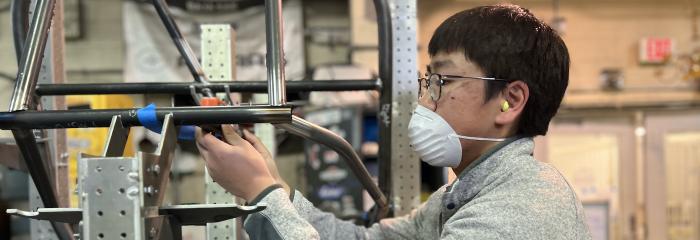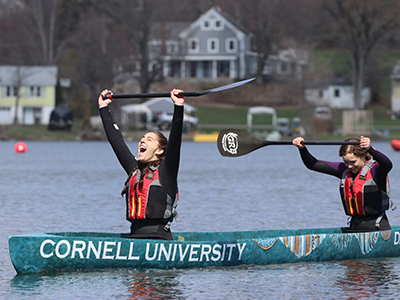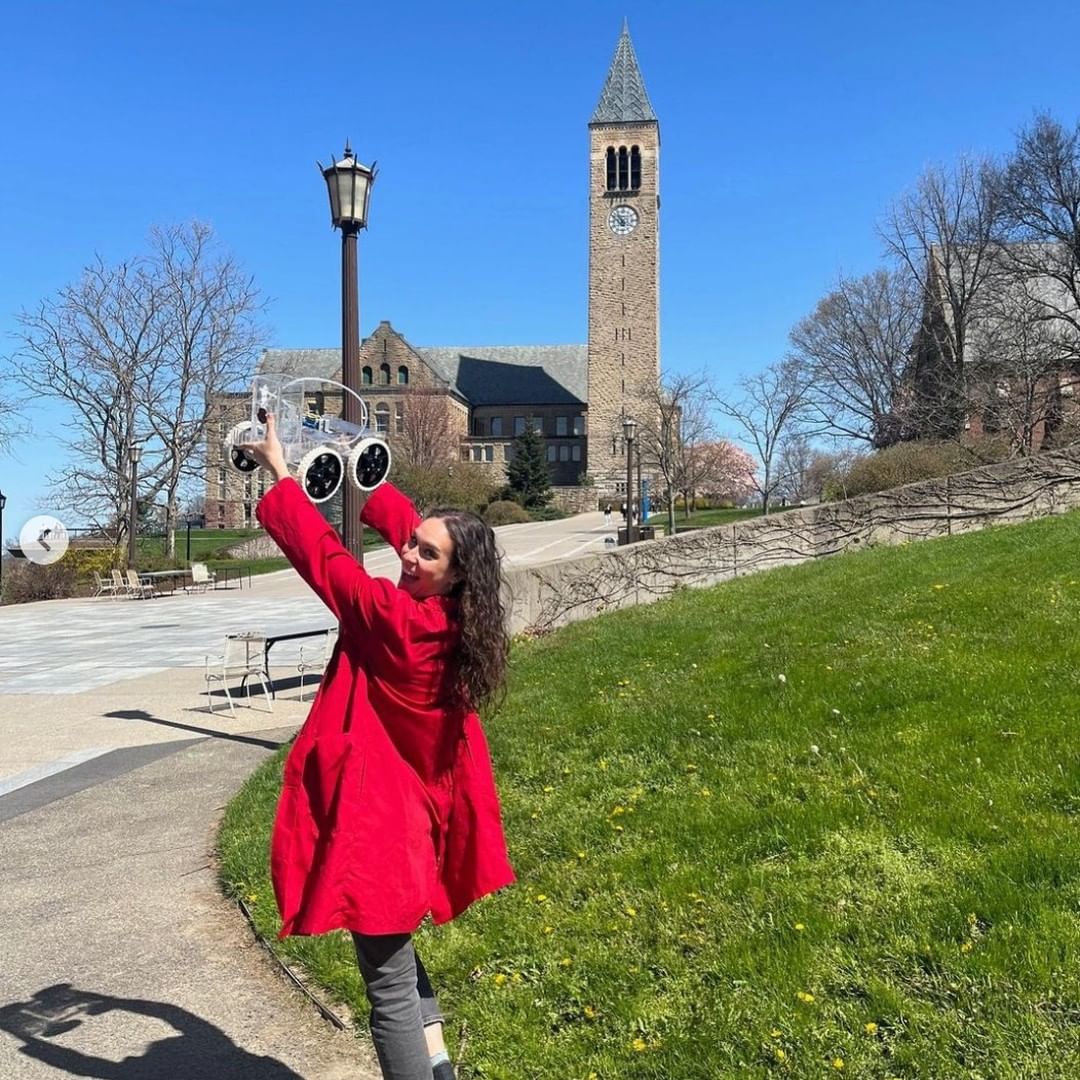
The gift of experiential learning: How one alum’s legacy is transforming Student Project Teams
By Reeve Hamilton
Of all the people Lauren Stulgis has interacted with since joining Cornell Engineering as the Swanson Director of Student Project Teams, James F. Cunningham ’71 stands out as a singular character – and not just because he was the first alum she met in person. “I knew Jim right away as someone who was very engaged in a different way than most other alumni,” she recalls.

A systems engineer with decades of experience, Cunningham would readily help student teams map out their projects — from designing and building high-powered rockets for competition to researching and implementing community-scale water treatment technologies — and alert them to potential opportunities within his professional network. During Stulgis’s first winter session, known as JanFab, Cunningham was a daily presence in the Experiential Learning Lab, the home of Student Project Teams, providing consultations and working one-on-one with students.
“His commitment to serving in that mentorship role is incredible,” said Stulgis, her inadvertent use of the present tense conveying Cunningham’s ongoing impact. “He’s passionate about the value and the power of systems engineering and hands-on learning, and he wants to be here working with the students.”
Cunningham passed away on September 2, 2022. In a conversation just a few days prior, he reflected on the program. “Most alumni go to class reunions and alumni events,” he said. “I was fortunate to work with the kids in project teams.”
Even though he will no longer be physically present, Cunningham’s impact will continue to be felt. A regular donor to the program throughout his life, he ultimately dedicated much of his estate to the establishment of the James F. Cunningham ’71 Assistant Director of Student Project Teams. Now held by Kate Reiter, the new position doubled the program’s full-time staff support, which has launched a new era for the storied Student Project Teams experience, enabling a wave of transformative changes.
Building on a strong foundation

Throughout its history, Cornell Engineering students have been drawn to opportunities for hands-on learning and collaborative teamwork. In 1909, even before a formal course in aerial engineering was offered, students formed the Cornell Aero Club and began entering gliders in intercollegiate competitions. It would be another six decades or so before a renewed focus on engineering design education and the encouragement of a young faculty member named Albert R. George – now the John F. Carr Professor of Mechanical Engineering Emeritus – prompted the original formation of what would become today’s Student Project Teams.
Coming on board, Stulgis saw a lot of opportunity. “I think there is a lot of recognition, especially with the college’s focus on experiential learning in our new strategic plan, of just how valuable this type of hands-on education is,” she said. “And that is also coming from the students. The demand for participating in project teams and active learning just continues to grow and grow.”
She was eager to develop a framework that would allow that growth to be strategic and sustainable, however, she quickly found herself hamstrung by two factors. The first was the onset of the COVID-19 pandemic, which significantly impacted opportunities for in-person work for about two years. The second was the fact that she was the only full-time staff support for over 1100 students. “There were a lot of more strategic, big-picture things that I wanted to tackle that just were not possible because I was also responsible for the day-to-day operations,” she said.
That changed in January 2022, following the commitment from Cunningham. With the addition of Reiter, who has multifaceted experience in both engineering and education, the expanded project team staff — which added a third full-time member in late 2022 — wasted no time implementing ideas for improvements that had, by then, been percolating for years.
New curriculum, new processes, new teams

One of the distinguishing features of Student Project Teams has long been that students earn academic credit for their work. Working with a faculty committee, Stulgis has implemented a new “flexible, yet specific” approach to ensure that standards and expectations for the assigning of grades and earning of credit are applied consistently. More than two dozen departmental independent study courses previously used for project team work have been supplanted by a single college-level course with a section designated for each project team.
“For the students, we want them to intentionally articulate their learning objectives and reflect on their experiences,” Stulgis said. “And for the faculty, we want them to be able to focus on the fun aspects of educating, and we can provide the administrative support.”
The last year also saw a more formalized application process put in place for groups interested in becoming a Student Project Team. Following the new process, which was developed in collaboration with existing project team members, would-be teams have to demonstrate – both to the staff and to their peers in the program – that they have a forward-looking vision, a clear organizational structure, and well-defined processes in place to allow for the transfer of knowledge and student leadership from one year to the next, among other criteria.
“There is a lot of student ownership in this new process, which really helps us set the tone and make it clear to the new teams that we’re all here to support them and make sure they have the resources they need,” Stulgis said. “It also gives us the opportunity to ensure that we are positioned to help them succeed and take that next step, which for many of them is the curricular piece.”
Four new teams have been added thus far in the current academic year, bringing the total number of project teams to 34 — with more expected to be added this year.

One of the new teams, Cornell Custom Silicon Systems, or C2S2, leveraged generous funding from another dedicated alumnus to become a Student Project Team. Working with Chris Batten, an associate professor of electrical and computer engineering, they applied for funding and team status via the Shen Fund for Social Impact. The Shen Fund – named for Cornell Engineering alumnus David t. Shen ’89, managing director of the private equity group Olympus Capital Holdings Asia — was established in 2018 to launch and support projects that employ technology in an innovative manner to generate high impact on society. C2S2 joins three existing Shen Fund-supported project teams.
“Many of the companies Cornell Engineering students are applying to want experience with semiconductors,” said Aidan McNay ’24, the co-founder and team lead for C2S2, “but nobody at the undergrad level typically gets that experience until later on. Students need to have that knowledge, so we thought it would be really valuable for students to get that experience through a hands-on project team.”
Two other existing clubs, the Cornell Biomedical Device team, often referred to as CUBMD, and Hack4Impact, a university chapter of a national organization, successfully made the transition to Student Project Team status. Pursuing the change in designation — even with the more rigorous application process — was attractive, in part, because of how it changes an organization’s standing on campus.
“Project teams are a really big part of campus, and people are really interested in them,” said Miyuki Goay ’22, the engineering chair for Hack4Impact, which connects student software developers with nonprofits and other socially responsible businesses to develop digital tools for social change. “We want to try to reach out to as many people who are passionate about social impact as we can, and I think being a project team allows us to do that.”

Being a Student Project Team also opens up access to additional resources that are not available to other student clubs, which Molly Eron ’23, the team lead for CUBMD, believes could be game-changing for her group. Since joining the club as a first-year student, she has worked on projects like BruxFree, an over-the-ear Bluetooth device intended to reduce teeth-grinding, and MyeMonitor, a wearable sensor used to track the neuromuscular symptoms of multiple sclerosis.
While neither concept is ready for market, they did offer Eron the opportunity to acquire an impressive range of skills: everything from soldering, to using computer-aided design software, to team leadership. Now that CUBMD is a Student Project Team, she’s ready to take on a new challenge. “We finally have the resources and support to push forward with our products and move past the prototyping phase we’ve been stuck in,” she said.
An enduring impact
While he did not get to meet all the students that will benefit from the increasing support and structure in the growing Student Project Teams program, Cunningham did spend time with Reiter, the first staff member to hold the position named for him.
“He loved Cornell very much, and he was so welcoming of me, and just so engaged with what we were doing,” Reiter said. Noting that the program seems to foster such dedication, Reiter remembers walking into the project team space in Upson Hall on the day before fall 2022 classes started, the first without significant restrictions since the onset of COVID-19. Some of the students had arrived on campus mere hours earlier, making a beeline to the space before they had even unpacked.
Jim exhibited this same eagerness, often arriving to the Project Teams office first thing in the morning with a packaged peanut butter and jelly sandwich in his pocket because he wanted to spend as much of his campus visits in the ELL as possible.

“I think something that sometimes gets lost in the shuffle of all the other amazing things they’re doing is that this is their main home at Cornell,” she said. “They are surrounded by fellow students who are supporting them and that they’re connected with, and this is their community.”
Specifically, it is a community oriented toward doing and learning collaboratively, something that clearly resonated with Cunningham. “In this program, students really learn how to think. They learn differently when they’re involved,” he said. “It is the real work of the university.”
It’s work that can only happen because of his generous support.
“He has made sure that we will have front-line student support for years and years to come,” Stulgis said. “It’s the most Jim thing ever.”
Eric Laine and Tony Simione contributed to this story.

